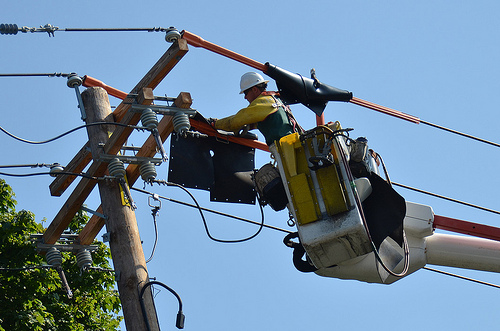 New York – New Yorkers frustrated with power outages more than two weeks after Superstorm Sandy took one of the region’s major utilities to court on Tuesday, arguing residents were forced to live in the cold and dark due to negligence and an obsolete system for dealing with major crises.
New York – New Yorkers frustrated with power outages more than two weeks after Superstorm Sandy took one of the region’s major utilities to court on Tuesday, arguing residents were forced to live in the cold and dark due to negligence and an obsolete system for dealing with major crises.
Subscribe to our Daily Roundup Email
Tempers have been rising across areas slammed by the storm, which hit on October 29, killing at least 121 people, causing an estimated $50 billion in property damage and economic losses and triggering widespread power and transportation outages.
While hundreds of thousands of people have had power restored, more than 130,000 customers remained without electricity and heat.
“No power, and it is freezing!” said Diane Gregg, 55, who lives in public housing in Red Hook, Brooklyn, in a building that remained without power. Despite a light rain, she stood outside where she said it was warmer than in her apartment.
While workers were cleaning up nearby buildings, raking leaves and visiting house-bound residents, there was no sign of power being restored, she said.
“We don’t know why,” she said. “You really don’t get any answers.”
In a search for answers, a class action lawsuit was filed against the Long Island Power Authority, a state-owned power company. Brought on behalf of Long Island residents, it claims LIPA failed to replace an “outdated, obsolete” management system for dealing with large-scale power outages.
The flaws in its system were documented in a report issued by the New York State Public Commission, which regulates utilities, last year after Hurricane Irene, the complaint said.
LIPA said it expected to restore service on Tuesday to most of its New York customers, but that more than 84,000 homes and businesses will stay dark due to saltwater flooding that could have damaged electrical panels, wires, outlets and appliances, making it unsafe to restore electricity.
Utilities say those homes and businesses must be inspected, repaired and certified before service can resume.
In New York, Consolidated Edison Inc has said it had about 16,300 customers who could not regain electric service, and in New Jersey, Jersey Central Power and Light utility has said about 30,000 customers could not have power restored.
The utilities have come under fire not only by residents but also the region’s leaders. New York Governor Andrew Cuomo said on Monday he intended to launch an investigation, blasting their storm responses and Con Edison’s stated intention to seek rate increases.
“I think it adds insult to injury,” Cuomo said. “I think the utilities should be taking about rebating to the rate-payers.”
The devastation in New York City was set for an inspection on Thursday by newly re-elected President Barack Obama. The president toured storm-ravaged areas of New Jersey days ahead of last week’s election with Republican Governor Chris Christie, whose strong praise for Obama’s storm response was seen as helping boost his showing at the polls.
In Manhattan, workers were readying an 80-foot-tall tree, whose New Jersey owner told local media swayed during the superstorm, to be installed on Wednesday in Rockefeller Center. There, it will be decorated with more than 30,000 lights to become one of the city’s most beloved holiday sights.
As part of the city’s efforts to help storm victims, Mayor Michael Bloomberg said seven “one-stop” centers were being set up to provide information and disaster assistance.
He said the city’s gas rationing system, under which cars with odd- and even-numbered license plates can fill up only on alternate days, would continue for at least another five days, at which time officials would assess the situation.
He said the program, put into place on Friday morning, has succeeded in shortening lines at gasoline stations. Since Sandy, the region has faced severe fuel shortages due to power outages and inventory stranded at refineries and terminals.
New Jersey’s similar gas rationing system, launched on November 3, came to an end on Tuesday morning.
Commuters’ headaches were easing slightly, as PATH trains that connect New York and New Jersey resumed some limited service on Tuesday. But two of New Jersey Transit’s major train lines remained suspended.
